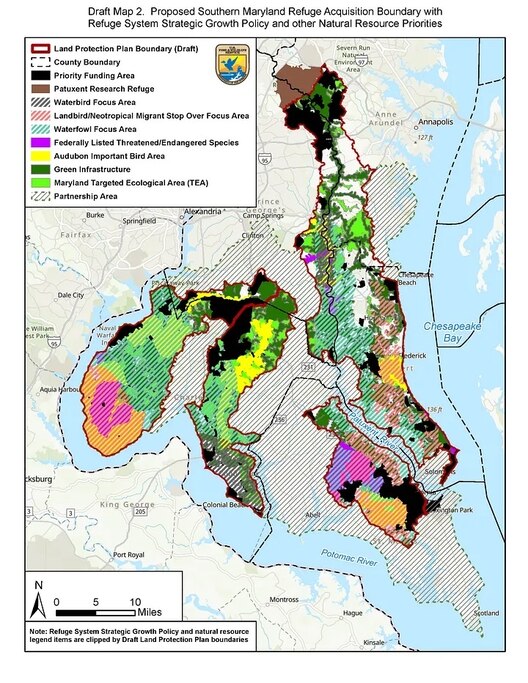After a close to 15-year push by conservationists, a swath of southern Maryland is getting protections as a national wildlife refuge, federal officials announced Friday, marking the first time an area of the Chesapeake Bay watershed has received that status in more than 25 years.
The Southern Maryland Woodlands National Wildlife Refuge would protect up to 40,000 acres spread across a large area spanning Anne Arundel, Calvert, Charles, Prince George’s and St. Mary’s counties, mostly south of Washington, D.C.
Under this new designation, the U.S. Fish and Wildlife Service has begun acquiring acreage in the designated area, either directly purchasing land and entering into easement agreements with willing private landholders, according to the Center for Western Priorities, a conservation advocacy nonprofit. Earlier this month, the federal agency acquired its first patch of land for this refuge, a 31-acre parcel of forest in Nanjemoy, Charles County.
Maryland Sen. Chris Van Hollen, who joined U.S. Interior Secretary Deb Haaland, Fish and Wildlife Service Director Martha Williams and conservationists Friday in Nanjemoy to announce the new refuge, called the step a historic day for the state.
The Baltimore Banner thanks its sponsors. Become one.
Van Hollen, who has worked in Congress to secure funding for the wildlife refuge program, pointed to the vast diversity of species this initiative will help protect in Southern Maryland and noted that, if the federal government succeeds in acquiring the full 40,000 acres, it would establish the largest wildlife refuge in the state.
Among the many benefits of this effort, environmental advocates argue that the refuge will help build resiliency against the changing climate, while protecting forest and wetland habitat, birds, hundreds of types of finfish and threatened species like sturgeon, tiger beetles and the northern long-eared bat.
Conservationists celebrated the announcement as a landmark step for protecting lands in the face continued deforestation and expanding development.
“This is one of the most pristine landscapes in the Chesapeake Bay watershed’s western shore, and it faces many threats,” Chesapeake Conservancy President Joel Dunn said in a statement. “This new refuge offers an opportunity to halt and even reverse biodiversity loss in this important place, and in a way that fully integrates and respects the leadership and rights of Indigenous peoples and local communities.”

It’s been a quarter century since any area of the Chesapeake Bay has been granted national wildlife refuge protections, and even longer since any of these refuges has been established in Maryland. The last wildlife refuge created in Maryland was Kent County’s small, 2,200-acre Eastern Neck Island, which received the protected status in 1962.
The Baltimore Banner thanks its sponsors. Become one.
President Joe Biden’s administration has taken explicit steps to bring more natural areas under federal protection, including through an executive order aimed at conserving 30% of the country’s lands and waters by 2030.
Four other new areas were included in the national refuge system under Biden in Florida, Montana, Tennessee and Wyoming, according to the Chesapeake Bay Foundation. The administration has also expanded existing wildlife refuges in New Mexico, North Carolina and Texas, for a potential of more than one million acres of voluntarily protected lands.




Comments
Welcome to The Banner's subscriber-only commenting community. Please review our community guidelines.